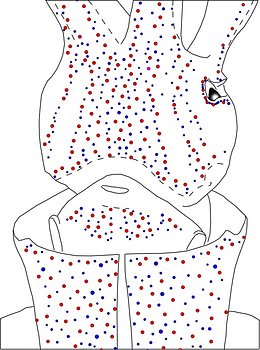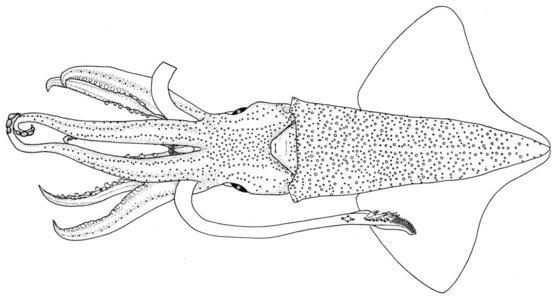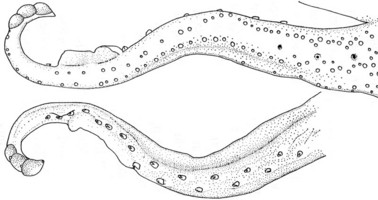Abraliopsis pacificus
Kotaro Tsuchiya and Richard E. YoungIntroduction
A. pacificus is distributed from the Northwest Pacific along the southern border of Kuroshio Current and its extension waters. Females reach at least 36 mm ML and males 26 mm ML.

Figure. Ventral view of a paratype of A. pacificus, female, 26 mm ML. Photograph by R. Young.
Brief diagnosis
An Abraliopsis (Abraliopsis) ...
- with dorsal flap (very small) on hectocotylus.
- with 16-30 (x̅ = 21) hooks on arm IV.
- with distribution in subtropical Northwestern Pacific.
Characteristics
In addition to familial characters (listed on the Enoploteuthidae page) and generic characters (listed on the Abraliopsis page), Abraliopsis pacificus has:- Tentacle clubs
- Two rows of Different-sized hooks on manus.
- Carpal flap and aboral keel, large.
- Head
- Occipital folds 2-4 not clearly connected by posterior crescent ridges.
- Head width index - Males: 30.7-39.9 (x̅ = 35.4, n = 5); Females: 30.9-33.8 (x̅ = 32.9, n = 5).
- Occipital folds 2-4 not clearly connected by posterior crescent ridges.
- Arms
- Arms IV of moderate length; ALI IV = 62-76 (x̅ = 68.2, n = 16).
- Arms with 16-30 hooks (mainly 16-23, x̅ = 21, n = 15) and 10-25 distal suckers.
- Hectocotylus
- Hectocotylus (right arm IV) with two different-sized flaps: long, narrow, proximal flap on ventral margin and short (about 1/4 length of ventral flap), distal flap on dorsal margin.
- Fin width index - 88-95 (x̅ = 91.5, n = 10).
- Photophores
- Ocular photophores: 5 photophores on each eye.
- Integumental photophores: Ventral mantle and head with scattered arrangement of photophores.
 Click on an image to view larger version & data in a new window
Click on an image to view larger version & data in a new window

Figure. Ventral views of the head and anterior mantle regions of an A. pacificus paratype, female 28 mm ML. Photograph showing integumental photophores. Right - Outline drawing from previous photograph with all integumental photophores represented by colored dots. Red dots - Complex photophores. Blue dots - Non-complex photophores. Images by R. Young.
More details of the integumental photophores can be found here.
- Ocular photophores: 5 photophores on each eye.
- Reproductive structures
- Spermatangia receptacles located dorsal-collar pocket on either side of nuchal cartilage.
-
Measurements and counts
Holotype
Paratype 2
Paratype 4
Paratype 8
Paratype 1
Paratype 3
Paratype 5
Paratype 7
Sex
Male
Male
Male
Male
Female
Female
Female
Female
Mantle length
26
26
25
23
36
35
34
32
Head width index
30.7
33.9
34.9
39.9
33.4
32.9
30.9
33.8
Fin Length index 76.6
81.2
78.3
77.7
76.9
75.6
74.7
76.2
Fin width index 90.8
87.9
95.2
92.3
91.2
90.2
90.3
92.9
Arm length index: I
36.4/33.0
35.8/36.6
37.4/45.4
42.5/44.4
46.3/44.9
40.4/41.8
45.0/47.7
49.9/45.8
II
43.3/48.7
32.3/44.8
51.4/53.0
49.4/59.2
52.9/50.7 45.2/43.2
54.1/55.6
52.9/57.6
III
46.7/42.2
41.3/38.9 44.2/49.4
53.2/53.7
47.7/52.1
43.5/43.2
49.1/48.8
54.8/51.1
IV
65.1/69.4
64.2/63.8
62.3/61.9
74.7/75.8
74.9/76.3
63.1/64.0
67.4/71.8
72.1/65.0
No. hooks, I
20
21
28
18
20
19
19
18
II
23
19
25
21
21
23
22
22
III
21
21
22
20
25
17
19
20
IV
17/17
16/20
16/16
16/16
20/23
-/18
19/19
18/17
Club length index 19.9/18.8
22.2/21.0
20.1/24.1
- /-
24.2/23.1
19.3/21.0
21.8/20.9
21.7/23.5
Comments
This Abraliopsis pacificus is sometimes confused with Abraliopsis sp. B (e.g., Young, 1978. 1995). A. pacificus, however, has ...
- a dorsal flap on the hectocotylus (flap absent in A. sp. B).
- a greater number hooks on arms IV than in A. sp. B.
- a narrower head then in A. sp. B.
See Abraliopsis (Abraliopsis) page for comparisons of all species of the subgenus.
Distribution
Geographical Distribution
This species is found in the Northwest Pacific between about 30° and 35° N. (Tsuchiya and Okutani, 1990).
References
Tsuchiya, K. 1993. Distribution and zoogeography of the family Enoploteuthidae in the Northwest Pacific. In: Okutani, T., O’Dor, R. K. and Kubodera, T. (eds.) 1993. Recent advances in fisheries biology (Tokai University Press. Tokyo). pp. 571-585.
Young, R. E. 1978. The vertical distribution and photosensitive vesicles of pelagic ceph- alopods from Hawaiian waters. Fish. Bull. 7 6 : 583-615.
Young, R.E. 1995. Aspects of the natural history of pelagic cephalopods of the Hawaiian mesopelagic-boundary region. Pacific Science, 49:143-155.
Title Illustrations

| Scientific Name | Abraliopsis pacificus |
|---|---|
| Location | Northwest Pacific |
| Reference | Tsuchiya, K. and T. Okutani. 1990. Abraliopsis pacificus, a new species of the squid family Enoploteuthidae from the Northwest Pacific. Bulletin of the National Science Museum, Tokyo, (series A)16(2):47-60. |
| Creator | K. Tsuchiya |
| Sex | Female |
| View | Ventral |
| Copyright | © 1990 Bulletin of the National Science Museum, Tokyo |
About This Page

Tokyo University of Fisheries, Tokyo, Japan

University of Hawaii, Honolulu, HI, USA
Page copyright © 2013 and
 Page: Tree of Life
Abraliopsis pacificus .
Authored by
Kotaro Tsuchiya and Richard E. Young.
The TEXT of this page is licensed under the
Creative Commons Attribution-NonCommercial License - Version 3.0. Note that images and other media
featured on this page are each governed by their own license, and they may or may not be available
for reuse. Click on an image or a media link to access the media data window, which provides the
relevant licensing information. For the general terms and conditions of ToL material reuse and
redistribution, please see the Tree of Life Copyright
Policies.
Page: Tree of Life
Abraliopsis pacificus .
Authored by
Kotaro Tsuchiya and Richard E. Young.
The TEXT of this page is licensed under the
Creative Commons Attribution-NonCommercial License - Version 3.0. Note that images and other media
featured on this page are each governed by their own license, and they may or may not be available
for reuse. Click on an image or a media link to access the media data window, which provides the
relevant licensing information. For the general terms and conditions of ToL material reuse and
redistribution, please see the Tree of Life Copyright
Policies.
- Content changed 03 November 2013
Citing this page:
Tsuchiya, Kotaro and Richard E. Young. 2013. Abraliopsis pacificus . Version 03 November 2013 (under construction). http://tolweb.org/Abraliopsis_pacificus/19690/2013.11.03 in The Tree of Life Web Project, http://tolweb.org/










 Go to quick links
Go to quick search
Go to navigation for this section of the ToL site
Go to detailed links for the ToL site
Go to quick links
Go to quick search
Go to navigation for this section of the ToL site
Go to detailed links for the ToL site